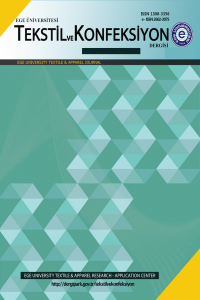HİDROJEN PEROKSİT AĞARTMASINDA AKTİVATÖRÜN BEYAZLIK DERECESİ VE HİDROFİLLİĞE ETKİSİ
Ağartma, Hidrojen peroksit, Ön terbiye, Aktivatör
THE EFFECTS OF ACTIVATOR ON WHITENESS AND HYDROHILITY DURING THE HYDROGEN PEROXIDE BLEACHING
Bleaching, Hydrogen peroxide, Pretreatment, Activator,
___
- 1. Ahn B. J., Kondo R., Sakai K., 2001, ‘Effect of Activator on Hydrogen Peroxide Bleaching of White Ledger’, Ind. Eng. Chem., No: 5(7), p:285-291.
- 2. Maekawa M., Hashimoto A., Tahara M., 2007, ‘Effects of pH in Hydrogen Peroxide Bleaching of Cotton Fabrics Pretreated with Ferrous Sulfate’, Textile Research Journal, No: 4 (77), p:222-226.
- 3. Shahbaz B., Jamil N. A., Tusief M. Q., 2005, ‘Influence of various Bleaching Agents on Bleaching of Cotton Knitted Fabrics’, Jour. Chem. Soc. Pak., No:6(27), p:572-579.
- 4. Topalovic T., Nierstrasz V. A., Bautista L., 2007, ‘Analysis of the effects of catalytic bleaching on cotton’, Cellulose, 14, p:385–400.
- 5. dspace.lib.fcu.edu.tw/handle/2377/3917 (2009).
- 6. M. Blanco, J. Coello, M. J. Sánchez, 2006, ‘Experimental Design for Optimization of Peroxide Formulation Stability and Cost’, Journal of Surfactants and Detergents, No:4(9), p:341-347.
- 7. Westbroek P., Kiekens P., 2005, ‘Electrochemical behaviour of hydrogen peroxide oxidation: kinetics and mechanisms’, Analytical electrochemistry in textiles, Westbroek P., Priniotakis G., Kiekens P., Woodhead Publishing Limited, Cambridge, p:92-94.
- 8. Rouette H. K., 2002, ‘letter h’, Encyclopedia of Textile Finishing, H. K. Rouette, Springer-Verlag, Heidelberg, p:82-96 (CD book).
- 9. Brooks R. E., Moore S. B., 2000, ‘Alkaline hydrogen peroxide bleaching of cellulose’, Cellulose, 7, p:263–286.
- 10. Eren H. A., Aniş P., Yılmaz D., Kirişçi Ş., İnkaya T., 2009, ‘Combined use of laccase, ozone and hydrogen peroxide for cotton bleaching’, Tekstil ve Konfeksiyon, 4, p:299-303.
- 11. Karmakar S.R., 1999, ‘Bleaching of Textiles’, Chemical Technology in The Pre-Treatment Processes of Textiles, Elsevier, Amsterdam, p:170-172.
- 12. Cai J. Y., Evans D. J., 2007, ‘Guanidine Derivatives Used As Peroxide Activators for Bleaching Cellulosic Textiles’, Color. Technol., p:123, 115–118 .
- ISSN: 1300-3356
- Yayın Aralığı: Yılda 4 Sayı
- Başlangıç: 1991
- Yayıncı: Ege Üniversitesi
Mücella GÜNER, A. Aslı İLLEEZ, Can ÜNAL
3-BOYUTLU BOŞLUKLU YAPIDAKİ SANDVİÇ KOMPOZİTLERİN DARBE SONRASI SIKIŞTIRMASI
Haijian CAOI, Kun QIAN, Qufu WEI, Hongshun LI
ULTRASONİK ENERJİNİN KONFEKSİYON SANAYİİNDE KULLANIMI
POLİPİROLÜN POLİÜRETAN ESASLI KOMPOZİTLERİN ÖZELLİKLERİNE ETKİSİ
Meltem YANILMAZ, Fatma KALAOĞLU, Hale KARAKAŞ, A. Sezai SARAÇ
HİDROJEN PEROKSİT AĞARTMASINDA AKTİVATÖRÜN BEYAZLIK DERECESİ VE HİDROFİLLİĞE ETKİSİ
E. Perrin Akçakoca KUMBASAR, Ayşegül E. KÖRLÜ, Candan CAN
KONFEKSİYON ÜRETİMİNDE İSTATİSTİKSEL YÖNTEMLE MONTAJ HATTI DENGELEME
Selin Hanife ERYÜRÜK, Fatma KALAOĞLU, Murat BASKAK
POLİESTER ESASLI ÖRME KUMAŞLARIN REDÜKTİF YIKANMASI İÇİN YENİ YAKLAŞIMLAR
Deniz VURUŞKAN, Osman BABAARSLAN, İlhami İLHAN
ELEKTROSPINNING PROSESİ İLE ELASTOMERIK POLİMER LİF AĞININ ÜRETİMİ
Nuray UÇAR, Onur AYAZ, Mustafa ÖKSÜZ, Ayşen ÖNEN, Elif BAHAR, Mehmet UÇAR, Ali DEMİR, Mustafa İLHAN, Youjiang WANG
PAMUK/POLİESTER İPLİK KARIŞIMININ PARLAYAN PİGMENTLER İLE EMDİRME YÖNTEMİNE GÖRE BOYANMASI
Sabina BRAČKO, Tatjana RIJAVEC, Grega BIZJAK, Marija GORENEK
